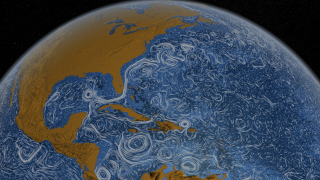Ocean Data and Activities

Overarching Question:
How are the oceans responding to climate change?
Introductory
Activities
Concept
Map
Students gain an understanding of how large scale ocean
processes are connected by drawing connections between ocean
pools, processes, and the factors that influence them. Can be
used to assess student prior knowledge.
• Ocean
Concept Map Example
• Ocean
Concept Map Teachers Guide
Satellite Images
Students learn how to interpret and
understand ocean satellite images by determining seasonal
patterns in sea surface temperature and chlorophyll
concentration on printouts of monthly images of the U.S. East
Coast from NASA's MODIS Aqua satellite.
• Satellite
Images Dataset
• Temperature
Profiles Dataset
• Image
Month Key
• Satellite
Images Handout- Student Version
• Satellite
Images Handout- Teachers Version
• Satellite
Images Teachers Guide
Ocean Satellite Data Modules:
Through the use of NASA's Data-enhanced
Investigations for Climate Change Education (DICCE) portal,
students gain hands-on experience using remotely sensed data
in the classroom. Step-by-step instructions walk
students through the use of the DICCE portal tool to
investigate various ocean processes. Teacher version with
suggested student answers are also available. All documents
are PDFs.
1. Seasonal Cycles Focus: What are the factors that control the patterns/cycles of phytoplankton growth in the North Atlantic Ocean?
Seasonal
Cycles- Student
Seasonal
Cycles- Teacher
2. Major Boundary Currents Focus: How do western
boundary currents influence climate and ocean productivity?
Boundary
Currents- Student Boundary
Currents- Teacher
3. Upwelling Zones Focus: How does nutrient concentration and upwelling influence phytoplankton growth in the Benguela upwelling zone?
Upwelling-
Student
Upwelling-
Teacher
4. The Southern Ocean
Focus: What
are the seasonal environmental characteristics of the Southern
Ocean?
Southern
Ocean- Student
Southern
Ocean- Teacher
5. Inter-annual Variability
Focus: Patterns in
sea surface temperature and chlorophyll concentration due to
El Niño/La Niña events.
El Niño-
Student
El Niño-
Teacher
Data in the Classroom: Exploring Climate Change in the Oceans
An online resource developed by NOAA for exploring ocean processes through the use of real, scientific data. Explore all curriculum models on the Data in the Classroom website.
Ocean
Acidification
Changing CO2 levels in the atmosphere can
affect the chemistry of the oceans. In the Ocean Acidification
module, students use real data to investigate the changing
ocean chemistry and its effects on ocean life.
• Explore the Ocean Acidification module online
